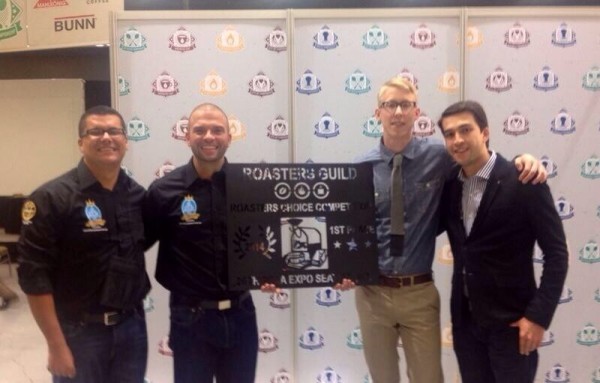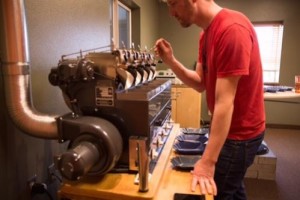
David Yake of Tony’s Coffee accepts the Roasters Choice Award with members of Granja La Esperanza at SCAA 2014.
Andrew Bowman has had a long relationship with Tony’s Coffee in Bellingham, Wash. The San Jose, Calif. micro with which he got his start in roasting in 2003 soon after merged with Tony’s, and it was nearly 10 years ago he relocated to Bellingham and took over as lead roaster. For the past two years, Bowman has been the company’s director of coffee, with a large hand in green buying, new product development and production team management.
Needless to say, he’s learned a thing or two in the process, and his breadth of knowledge and technical expertise have helped win Tony’s numerous awards for its coffees in recent years, including America’s Best Espresso at Coffee Fest last year, and the Roasters Guild‘s Roasters Choice trophy at the SCAA Event last month in Seattle.
For the Roasters Choice, Bowman and Tony’s submitted a Gesha variety from Cerra Azul in the Cauca Valley of Southern Colombia, which is managed by the team at Café Granja La Esperanza. We asked Bowman what goes into a Roaster’s Choice-winning coffee, and what the award means to him, to Tony’s and to the producers.
Can you tell us about the coffee?
GLE has been very successful with their cultivation of the Gesha varietal in Colombia, particularly with the Cerro Azul farm. The microclimate of Cerro Azul makes the Gesha grown there stand out from Gesha that is grown at lower elevations or in heavier (clay) soils, which may have a clean, pleasant profile, but lack the floral and tropical fruit intensity of the Cerro Azul Gesha. The microclimate is unique because the farm is located on a mountain range that separates the Cauca valley from the Pacific. This mountain range is where the cool coastal air meets the warm air rising off the valley floor. The swings in temperature causes a kind of stress in the plant, which encourages it to focus more energy into the fruit, resulting in more intense flavor. This is further encouraged by the high elevation.
For harvesting, workers must complete thorough ripeness trainings before being allowed to pick Gesha cherries. A specific group of workers that live in nearby areas is trained for the Gesha harvest. The cherry is sorted by a second group at the collection/weigh station. All cherry is transported to the washing station within 5 hours of being harvested.
Granja La Esperanza has developed very specific parameters for washing their Gesha. Floaters are removed before coffee enters the depulper. Within 2 hours of entering flotation tanks, the cherry goes through a water-less depulper. It then enters an anaerobic fermentation tank for 15 hours. They tried using a mechanical demucilager, but found that it created a less complex cup. Then they tried a 12 hour fermentation period, which is standard at their other farms, but they found that 15 hours was ideal for Gesha. Someone monitors the coffee during the entire 15 hour period – stirring, tasting, and feeling the coffee every 30-60 minutes. After fermentation, the coffee is washed and goes through channels to sort out floaters again. Then the coffee is hand sorted and dried outside for 2 hours before going into mechanical driers. They found that sun drying brought out cocoa and herbal notes in the coffee, while mechanical drying brought out floral and tropical fruit notes.
What is your approach to the coffee?
My goal when roasting Gesha Cerro Azul is to coax out aromatic qualities but not under-develop sweetness or body. While this varietal has good density, the shape of the seed allows for very efficient heat penetration, which is an important consideration. Batch size is kept at 80 percent or less of the roasting machine’s capacity to ensure even convection. Coffee was charged into the drum with sufficient heat to arrive at a bottom/turn temperature within a few minutes. I gradually ramped up heat through the drying phase until the coffee started to become exothermic. Heat was then reduced until the coffee just began to caramelize and various sensory cues indicated the right time to halt the roast. A relatively shallow roast curve, good airflow, and carefully controlled heat input were combined to achieve a good roast.
What’s in the cup?
Some of the flavors we noted from this roast were jasmine, lemongrass, passion fruit, and papaya.
Tell us about your relationship with Granja La Esperanza?
We just started working with coffee from Granja La Esperanza this year. Sustainable Harvest importers facilitated the relationship. David Yake, who oversees accounts and education at Tony’s, and myself will be visiting their farms for the fist time in late June. We are bringing along our good friend and colleague Caleb Young, who is a very talented filmmaker. We plan on working on some nifty new processing videos, so be on the look out for those.
What does the Roaster’s Choice mean to you? To Tony’s?
We’ve competed in Roaster’s Choice almost every year since its inception. I think it’s a really fun way to put some coffee out there and hopefully get some useful feedback from a different contingent of people than you are used to hearing from. I feel proud that my roast did well in this competition, but I also feel excitement for the attention our success brings to the producers who put infinitely more work into it than we did. Winning a competition is always good for marketing, and I think our customers get to share some of the pride in a win, which feels good.
Historically, the Roasters Choice takes place more behind the scenes. Do you see that as problematic?
It makes sense that Roaster’s Choice is in the background a bit. First off, it is completely devoid of the theatrics of any of the other coffee competitions. Coffee needs to rest to be evaluated correctly, so all of the work is done pre-competition. I can’t speak for everyone, but I think professional coffee roasting attracts a certain back-of-the-house personality type. So I’m sure most roasters don’t mind putting coffee front and center instead of themselves.
Tell us about your America’s Best Espresso win at Coffee Fest Seattle last year.
We competed with our Ganesha Espresso blend that we are very proud of. It is typically a blend of two or three coffees, but we don’t impose specific parameter requirements when we work with Ganesha. Our goal is to end up with espresso that has tremendous sweetness, body, and elegant fruit undertones. We are very intentional in our approach to roasting for espresso when it comes to this blend. It’s always a fun challenge.
Nick Brown
Nick Brown is the editor of Daily Coffee News by Roast Magazine.







Comment